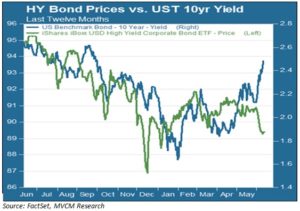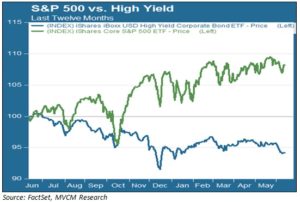
Interest rates are once again the trending topic as anticipation for the Fed’s June policy meeting next week grows. Last week we considered the potential impact of a Fed rate hike on equities and the possibility of a pullback. This week we shift the focus to what the Fed action might mean for your fixed income portfolio. Back at the beginning of the year, most economists predicted that the Fed would decide to raise rates in June – meaning next week. But after a string of weak economic data the consensus was pushed back, possibly even to next year. That being said, recent data including nonfarm payrolls and this week’s retail sales have been strong. A September rate move looms large, meaning that it is important to make sure that the fixed income portion of your portfolio is positioned accordingly.
Investors say Junk Bonds are indeed “Junk”
An article in the Financial Times week focused on outflows in high yield bond ETFs since the beginning of June, citing rising rates as a driver. This does not necessarily mean that you should get rid of your high yield exposure in anticipation of rising rates. High yield (or junk) bonds have been found in the past to be less interest rate sensitive than other investments. Rising rates can indicate an improving economy, which in turn means a better environment for companies with poor credit ratings (those companies are the ones issuing high yield bonds). For these and other reasons, junk bonds tend to trade more like equities than bonds – the Barclays US Corporate High Yield Bond Index is 74% correlated to the S&P 500 versus only a 16% correlation to the Barclays US Aggregate Bond Index over the past five years.
In fact, for much of the past year high yield prices have actually moved in the same direction as benchmark interest rates. As rates fell through the second half of last year, junk prices fell as well. When rates rose on the back of good economic news in February of this year, high yield prices performed well. Where this pattern broke decisively was just a couple weeks ago, when the 10-year yield spiked and junk bonds tanked. In other words, if recent outflows are being driven by rate perceptions, that would seem to be more of an anomaly than the “junk bonds fall when rates rise” rule suggested by the Financial Times’ article.

Call Me
There are two sides to every coin, and more risks to take into account than the directions of interest rates. Call risk affects any bond with call features, and this includes the vast majority of high yield bonds. Most high yield bonds have a maturity of 10 years but are callable at 5 years. In a falling rate environment these bonds tend to get called because the borrowers can then reissue the same bond with a lower interest rate, meaning their borrowing costs fall. In a rising rate environment the opposite will happen – the bond won’t get called because it would have to be reissued at a higher duration. Investors holding callable bonds can get the worst of both worlds – lower duration when rates fall and higher (i.e. more negative price sensitivity) when rates rise. When positioning portfolios for a rising rate environment it is important not to ignore the implications of call risk.
Imitation Game

Ever heard the disclosure “past performance is not indicative of future results”? The above chart illustrates why that regulatory disclosure is always worth keeping in mind. Even though junk bonds have historically performed more in line with equity markets than with fixed income, over the past eight months the correlation has been spottier than usual. Junk bonds mirrored equities until October, when stocks experienced a deep pullback. High yield followed stocks down, but then kept falling while the S&P 500 pulled a stunning V-shaped recovery.
Why the divergence? A considerable number of junk bond issuers are energy exploration and production companies, and the energy sector led the broader market down as oil prices were plunging. So even though the S&P 500 enjoyed a sharp recovery, investors dumped high yield bonds fearing a rise in energy-related default risk. A similar story happened back in 1999 and 2000: during the period of high volatility leading up to the implosion of the tech sector in 2000 (which also happened to be when a rate hike program was in place) junk bonds had a negative return and underperformed other asset classes.
When in Doubt, Diversify
Because it has been awhile since the last Fed policy decision to raise rates (eleven years to be exact), it is difficult to predict how the scenario will play out this time. The more recent data we have on rate hikes happened in the context of a 30 year macro bull market for bonds. If we are about to enter a secular rising rate environment (and we don’t know for sure if this is the case), the most recent comparable data we have to work of off is from 1951 – 1981 – it is safe to say that the world is vastly different now than it was back then. Quite possibly, we are entering into a whole new world of rising rates.
There are some logical assumptions we can make, though. Investments that are less interest rate sensitive (as indicated by shorter effective durations) are more likely to perform better in a rising rate environment. High yield bonds fall into this category, but as we saw above there really are no guarantees. It is more prudent to adjust your allocation accordingly in different market environments rather than to either eliminate an asset class altogether or double down on the one you think (based on past performance) likely to do best.
Floating rate debt, short-term fixed rate issues, agency & non-agency mortgage backs and asset backed securities can potentially help immunize your exposure to interest rate risk. As noted above, don’t forget about call risk. The bottom line is that when the terrain is uncharted, a well-diversified portfolio is likely to be the best way to avoid missteps.